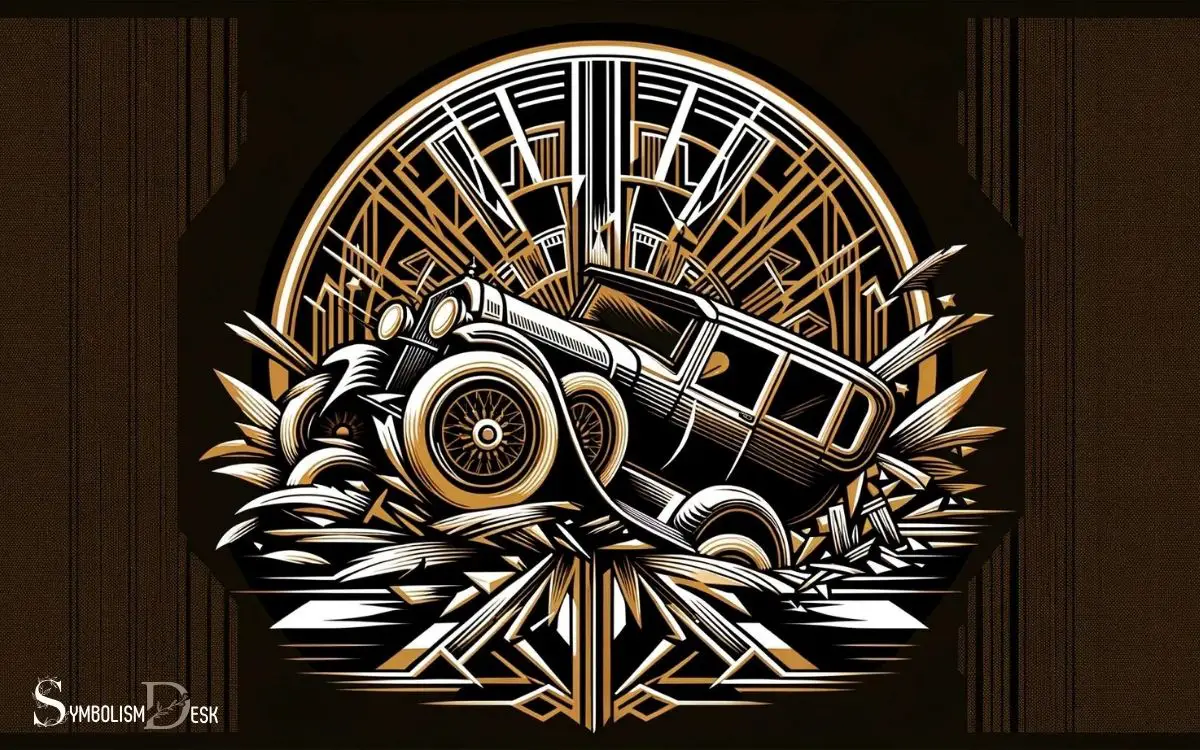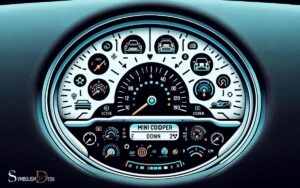What Does the Car Accident Symbolize in the Great Gatsby?
The car accident in F. Scott Fitzgerald’s “The Great Gatsby” symbolizes the destructive nature of the characters’ hedonistic lifestyle, the moral decay of society during the Roaring Twenties, and the ultimate demise of the American Dream.
It serves as a pivotal event that exposes the superficiality and recklessness of the elite, foreshadowing the tragic outcomes of their actions.
The car accident in “The Great Gatsby” is not just a plot device but a symbolic event that carries profound meanings:
The car accident in “The Great Gatsby” is a powerful narrative symbol that encapsulates the novel’s central themes of decadence and disillusionment.

Key Takeaway
The Symbolism of the Car Accident in “The Great Gatsby”
| Symbolic Element | Representation in the Novel |
|---|---|
| Recklessness | Characters’ carefree actions leading to the accident |
| Moral Decay | Indifference to the consequences of the accident |
| Social Class Collision | Clash between the wealthy and working class |
| American Dream | The unattainability and corruption of the dream |
| Foreshadowing | Prediction of the novel’s tragic ending |
The Car as a Status Symbol
The car in The Great Gatsby symbolizes both wealth and recklessness in the characters’ pursuit of status and power. The novel portrays cars as a status symbol, reflecting the characters’ desire to flaunt their newfound wealth. Gatsby’s car, with its extravagant design and bold yellow color, epitomizes this connection between material wealth and identity, serving as a physical manifestation of his ambition to impress Daisy and secure his place in the upper class. However, the vehicle also foreshadows the destructive consequences of excess and carelessness, as its role in Myrtle’s death highlights the darker side of such pursuits. Ultimately, Gatsby’s car symbolism meaning underscores the emptiness of equating self-worth with material possessions and blind ambition.
Jay Gatsby’s extravagant yellow car, for instance, represents his opulence and flamboyant lifestyle. The reckless driving and the car accident involving Daisy Buchanan also symbolize the characters’ carelessness and disregard for consequences as they chase after their desires.
The car’s symbolism extends beyond material wealth, serving as a metaphor for the characters’ moral corruption and the destructive effects of their pursuit of social status.
Through the car, F. Scott Fitzgerald conveys the darker aspects of the characters’ aspirations and the emptiness of their material pursuits in the Jazz Age.
Reckless Behavior and Moral Decay
The car accident in The Great Gatsby serves as a poignant symbol of reckless behavior and moral decay. It highlights the characters’ disregard for consequences and their indulgence in hedonistic pursuits.
This event underscores the overarching theme of the novel, portraying the destructive effects of unchecked decadence on individuals and society.
Symbolism of Car Accident
In Gatsby, the car accident symbolizes the characters’ reckless behavior and moral decay. The symbolism of the car accident in
The Great Gatsby serves to convey deeper themes and messages about the characters and the society they live in.
- Dangerous Pursuits: The reckless driving and the resulting car accident reflect the characters’ pursuit of pleasure and excitement without regard for consequences.
- Moral Corruption: The car accident highlights the moral decay and carelessness prevalent among the characters, emphasizing their lack of concern for the well-being of others.
- Class Divide: The car accident also illustrates the disparity between the wealthy and the working class, showcasing how the wealthy characters’ reckless behavior has serious consequences for those around them.
The car accident symbolizes not only a moment of tragedy but also serves as a metaphor for the characters’ heedless and decadent lifestyles.
Impact on Characters
An examination of the impact on characters in The Great Gatsby reveals their reckless behavior and moral decay following the car accident.
The car accident serves as a catalyst for the characters’ unraveling, particularly in the case of Daisy and Gatsby. Daisy’s reckless driving leading to Myrtle’s death reflects her moral decay and lack of accountability.
Gatsby’s involvement in covering up the accident showcases his willingness to protect Daisy at any cost, even if it means sacrificing his integrity.
The aftermath of the car accident exposes the characters’ inner turmoil and ethical deterioration, highlighting the consequences of their heedless actions.
This pivotal event underscores the theme of moral corruption and the devastating effects of irresponsibility, ultimately contributing to the tragic downfall of the characters in the novel.
Collision of Social Classes
The car accident in The Great Gatsby serves as a powerful symbol of the collision of social classes. It highlights the clash between the old money and the new money, as well as the reckless behavior that stems from the pursuit of wealth and status.
Through the characters’ interactions and the aftermath of the accident, Fitzgerald depicts the stark divide and the tensions that arise from the disparity in social hierarchy.
Class Conflict Symbolism
The car accident’s symbolism in The Great Gatsby vividly depicts the collision of social classes through the characters’ interactions and the resulting consequences.
- Destruction of the American Dream: The car accident serves as a metaphor for the destruction of the American Dream, highlighting the corrupting influence of wealth and social status.
- Clash of Values: The collision represents the clash of values between the old money represented by Tom and Daisy Buchanan and the new money represented by Jay Gatsby, exposing the stark differences in their lifestyles and priorities.
- Fatal Consequences: The car accident ultimately leads to tragic consequences, underscoring the devastating impact of the class conflict and the characters’ inability to bridge the gap between their respective social statuses.
Social Hierarchy Depiction
The car accident’s symbolism in The Great Gatsby vividly depicts the collision of social classes through the characters’ interactions and the resulting consequences, providing a poignant portrayal of the devastating impact of wealth and social status on the characters’ lives.
The collision between Tom Buchanan’s mistress, Myrtle Wilson, and Gatsby’s car, driven by Daisy Buchanan, starkly illustrates the clash of social classes in the novel.
Myrtle, who is from a lower socio-economic class, aspires to rise above her station by having an affair with Tom, who comes from old money.
The accident serves as a brutal reminder of the insurmountable barriers between social classes and the tragic consequences that arise from attempting to bridge them.
It highlights the stark disparities in power, privilege, and opportunity that exist within the society of the novel, offering a poignant commentary on the destructive nature of class divisions.
Implications of Carelessness
In the Great Gatsby, the car accident symbolizes the implications of carelessness for the characters involved.
Firstly, it highlights the reckless behavior of the wealthy elite, such as Tom Buchanan, who drives carelessly without facing consequences due to his social status.
This carelessness reflects a sense of entitlement and disregard for others. Secondly, the car accident serves as a metaphor for the moral and emotional wreckage caused by the characters’ thoughtless actions.
It demonstrates how their heedless pursuit of pleasure and fulfillment leads to devastating outcomes.
Lastly, the car accident underscores the theme of irresponsibility and the failure to consider the impact of one’s actions on others, revealing the shallowness and lack of empathy prevalent among the characters in the novel.
Foreshadowing Tragedy and Loss
Foreshadowing the impending tragedy and loss in The Great Gatsby, the car accident serves as a pivotal event that sets the stage for the unraveling of the characters’ lives.
The collision involving Myrtle Wilson and Gatsby’s car foreshadows the profound tragedies and losses that await the characters.
This event marks the beginning of the disintegration of their lives, symbolizing the impending doom and the irreversible consequences of their actions.
The carelessness and recklessness leading up to the accident foreshadow the moral and emotional downfall of the characters, hinting at the impending tragedies that will befall them.
The car accident becomes a harbinger of the impending tragedy and loss that will eventually engulf the characters, setting the tone for the subsequent disintegration of the American Dream.
Disintegration of the American Dream
The car accident symbolizes the disintegration of the American Dream in The Great Gatsby, portraying the irreversible consequences of moral and emotional downfall for the characters.
This pivotal event serves as a metaphor for the crumbling of the American Dream, revealing the following:
- Corruption of Values: The car accident represents the moral decay and corruption prevalent in the pursuit of the American Dream, as characters prioritize wealth and status over integrity and compassion.
- Illusion of Success: The collision exposes the hollowness of the characters’ materialistic achievements, highlighting the emptiness and disillusionment that accompany the unattainable American Dream.
- Breakdown of Relationships: The repercussions of the car accident lead to fractured relationships, reflecting the breakdown of genuine human connections amidst the relentless pursuit of the American Dream.
The disintegration of the American Dream in The Great Gatsby is a poignant commentary on the destructive nature of unrestrained ambition and the fragility of happiness.
This sets the stage for a deeper exploration of the themes of escape and disillusionment in the subsequent section.
Escape and Disillusionment
Amidst the wreckage of shattered dreams and fractured relationships, the characters in The Great Gatsby seek avenues of escape from their disillusionment, but find themselves ensnared in the relentless pursuit of unattainable aspirations.
The allure of wealth and social status drives them to desperately seek ways to break free from their disillusioned lives. However, their attempts at escape often lead to further entrapment in the cycle of unfulfilled desires and moral decay.
| Character | Avenue of Escape | Result |
|---|---|---|
| Jay Gatsby | Accumulating wealth | Tragic isolation |
| Daisy Buchanan | Seeking love elsewhere | Emotional emptiness |
| Tom Buchanan | Exerting power | Moral corruption |
| Myrtle Wilson | Pursuing materialism | Tragic demise |
| Nick Carraway | Seeking moral clarity | Disillusionment |
The characters’ pursuit of escape reflects the universal human experience of grappling with disillusionment and the often futile search for solace in external pursuits.
Consequences and Guilt
Seeking to understand the consequences and guilt that arise from their actions, the characters in The Great Gatsby grapple with the aftermath of their choices, further entangling themselves in a web of moral ambiguity and emotional turmoil.
- Betrayal and Deceit: Characters like Tom Buchanan and Daisy Buchanan grapple with the guilt of betraying their spouses and deceiving others for their own selfish desires.
- Tragic Endings: The consequences of their actions lead to tragic endings for multiple characters, causing them to confront the weight of their decisions and the impact they have on others.
- Internal Conflict: Throughout the novel, characters like Jay Gatsby and Nick Carraway struggle with the consequences of their past actions, leading to internal conflict and a sense of guilt that shapes their behavior and relationships.
Conclusion
In the end, the car accident in The Great Gatsby serves as an allegory for the moral decay and consequences of the characters’ actions.
It symbolizes the collision of social classes, the disintegration of the American Dream, and the consequences of recklessness and carelessness.
Through this tragic event, the novel conveys a deeper message about the fragility of societal values and the inevitable consequences of pursuing wealth and status at any cost.






